Pair of Linear Equations in Two Variables
Inconsistent, Consistent, And Dependent Pairs Of Linear Equations
Linear equations in two variables are equations where we have two variables. We require two equations to find the solution of linear equations in two variables. Go through the following video to understand the basic concept of linear equations in two variables.
Remember: To solve a linear equation in one variable, only one equation is required. To solve linear equations in two variables, two linear equations in the same two variables are required. Likewise, we can say that to solve linear equations with n number of
variables, n numbers of linear equations in the same n number of variables are required. The general form of a pair of linear equations in two variables is written as
 , where a1, b1 are real numbers and
, where a1, b1 are real numbers and (i.e., a1, b1 ≠ 0)
(i.e., a1, b1 ≠ 0)
 , where a2, b2 are real numbers and
, where a2, b2 are real numbers and (i.e., a2, b2 ≠ 0)
(i.e., a2, b2 ≠ 0)
We know that the solution of a linear equation must satisfy the equation. Conversely, we can say that the value of the variable in the equation, which satisfies the equation, is the solution of the equation.
In case of a pair of linear equations, the values of x and y, which satisfy both the equations, are the solutions of the equation.
Geometrically, a linear equation represents a straight line. Every solution of an equation is a point on the line represented by the equation.
Likewise, a pair of linear equations represents two straight lines. When their graphs are drawn, there are three possibilities. Let us go through the video to understand the various possibilities.
Example 1: Find whether the given pairs of linear equations are consistent or inconsistent?
(a) 5x + 2y = 2 20x + 8y = 1
(b) 4x + y = 8
7x – 2y = 1
(c) 5x + 6y = 9
10x + 12y = 18
Solution:
(b) 4 x + y = 8
7x – 2y = 1
Here, a1 = 4 b1 = 1 c1 = –8
a2 = 7 b2 = –2 c2 = –1


Therefore, according to the above rule, this system of equations has a unique solution. It is represented by intersecting lines.
(c) 5x + 6y = 9
10x + 12y = 18
Here, a1 = 5 b1 = 6 c1 = –9
a2 = 10 b2 = 12 c2 = –18


Therefore, according to the above rule, this system of equations has infinite solutions. It is represented by coincident lines.
Example 2: There are two lines drawn in each of the following graphs. Each line represents a linear equation in two variables. State whether the pair of linear equations represented in each graph is consistent, inconsistent, or dependent.
(a)
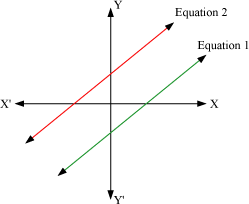
(b)
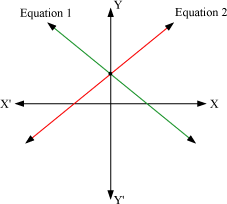
(c)
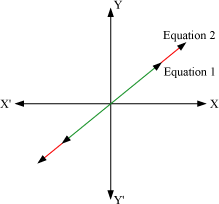
Solution:
(a) In the given graph, the lines representing the two equations are parallel to each other and never intersect. Thus, the lines in this graph represent an inconsistent pair of linear equations in two variables as they do not have any solution.
(b) In the given graph, the lines representing the two equations intersect at a point. Thus, the lines in this graph represent a consistent pair of linear equations in two variables as they have a unique solution.
(c) In the given graph, the lines are coincident i.e., the same line represents the two equations. Thus, the lines in this graph represent a dependent pair of linear equations in two variables as they have infinite number of solutions.
Expressing Given Situations Mathematically
We come across many situations in real life when it is easy to find the solution, if we express them mathematically.
Let us see such a situation.
The coach of the school cricket team buys 5 bats and 20 leather balls for Rs 3500. After some time, some more boys joined the team for practice, so he buys another 4 bats and 15 balls for Rs 2750. Suppose that the price of bat and ball does not change in the time period.
Can we express this situation mathematically to find out the individual prices of a ball and a bat?
Let the price of a bat be Rs x and that of a ball be Rs y.
It is given that 5 bats and 20 balls cost Rs 3500.
∴ Cost of 5 bats = 5x
And cost of 20 balls = 20y
⇒ Cost of 5 bats and 20 balls = 5x + 20y
⇒ 5x + 20y = 3500
Similarly, it is also given that 4 bats and 15 balls cost Rs 2750.
⇒ 4x + 15y = 2750
Therefore, the algebraic representation of the given situation is
5x + 20y = 3500 … (1)
4x + 15y = 2750 … (2)
After solving these equations, we can find out the individual prices of the ball and the bat. Let us see some more examples.
Example 1: Aman and Yash each have certain number of chocolates. Aman says to Yash, if you give me 10 of your chocolates, I will have twice the number of chocolates left with you. Yash replies, if you give me 10 of your chocolates, I will have the same number of chocolates as left with you. Write this situation mathematically?
Solution:
Suppose Aman has x number of chocolates and Yash has y number of chocolates.
According to the first condition, Yash gives 10 chocolates to Aman so that Aman has twice the number of chocolates than what Yash has.
⇒ x + 10 = 2(y – 10)
According to the second condition, Aman gives 10 chocolates to Yash such that both have equal number of chocolates.
⇒ y +10 = x – 10
Thus, the algebraic representation of the given situation is
x + 10 = 2(y – 10) … (1)
y +10 = x – 10 … (2)
Example 2: Cadets in the military academy are made to stand in rows. If one cadet is extra in each row, then there would be 2 rows less. If one cadet is less in each row, then there would be 3 more rows. Express the given situation mathematically?
Solution:
Let the number of cadets in each row be x and the number of rows be y.
Total number of cadets = number of rows  number of cadets in each row
number of cadets in each row
It is given to us that when one cadet is extra in each row, there are 2 rows less.
∴ xy = (y – 2) (x + 1)
xy = xy – 2x + y – 2
2x – y = – 2 … (1)
It is also given to us that if one cadet is less in each row, then there are 3 more rows.
∴ xy = (y + 3) (x – 1)
xy = xy + 3x – y – 3
3x – y = 3 … (2)
Thus, the algebraic representation of the given situation is
2x – y = – 2 … (1)
3x – y = 3 … (2)
Graphical Solution of a Pair of Linear Equations In Two Variables
Suppose you go to a stationary shop to buy some registers and pens. If you buy two registers and two pens, then you have to pay Rs 30. However, if you buy two registers and four pens, then you have to pay Rs 40.
Now, how can we represent this information algebraically, i.e., in the form of equations? Let us denote the cost of each register by Rs x and that of each pen by Rs y.
Now, it is given to us that two registers and two pens cost Rs 30.
∴ 2x + 2y = 30
⇒ x + y − 15 = 0 … (1)
We also know that two registers and four pens cost Rs 40.
∴ 2x + 4y = 40
⇒ x + 2y − 20 = 0 … (2)
Thus, we now have two linear equations in two variables from the given situation.
x + y − 15 = 0 … (1)
x + 2y − 20 = 0 … (2)
These two equations are known as a pair of linear equations in two variables. If we try to individually solve each equation, we will be unable to do so. We can arrive at an answer only if we try and solve both these equations together.
The general form of a pair of linear equations in two variables is written as
 , where a1, b1, c1 are real numbers, and
, where a1, b1, c1 are real numbers, and (i.e., a1, b1 ≠ 0)
(i.e., a1, b1 ≠ 0)
 , where a2, b2, c2 are real numbers, and
, where a2, b2, c2 are real numbers, and  (i.e., a2, b2 ≠ 0)
(i.e., a2, b2 ≠ 0)
A pair of linear equations represents two straight lines. When their graphs are drawn, there are three possibilities.
(i) The two lines may intersect at one point.
(ii) The two lines may be parallel.
(iii) They may represent the same line, i.e. they may be coincident.
The solution of a pair of linear equations is the point of intersection of their graphs.
Similarly, you can also graphically prove two lines to be inconsistent. Try it out yourself.
Limitations of graphical method:
- If the large values of variables are involved in the solution of system of linear equations then it is not convenient to use graphical method.
- If the fractional values of variables are involved in the solution of system of linear equations then it is not possible to obtain accuracy through graphical method.
- If the angle between two lines is small then the exact point of intersection cannot be obtained through graphical method.
Now, let us solve some examples to understand this concept better.
Example 1: Anshuman and Vikram have 10 marbles with them. Twice the number of marbles with Anshuman is equal to three times the number of marbles with Vikram. Solve this question graphically.
Solution:
Let us suppose that Anshuman has x marbles and Vikram has y marbles.
From the given information, we can form two equations as
x + y = 10
⇒ x + y − 10 = 0 … (i)
2x = 3y
⇒ 2x − 3y = 0 … (ii)
A table can be drawn for the corresponding values of x and y for equation (i) as
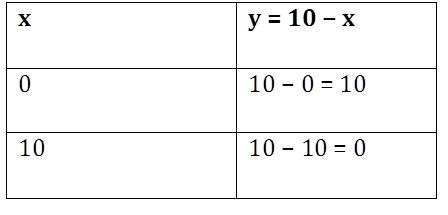
Similarly, a table can be drawn for the corresponding values of x and y for equation (ii) as
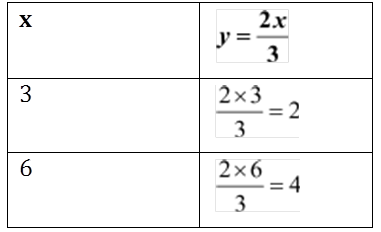
The two equations can be plotted on a graph as
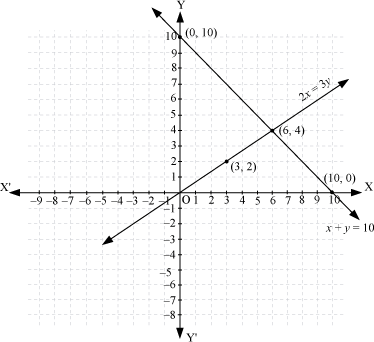
As seen in the graph, the two lines intersect at the point (6, 4).
This implies that the solution for the pair of linear equations is x = 6 and y = 4. Thus, Anshuman has 6 marbles while Vikram has 4 marbles.
Example 2: Find graphically whether the following pairs of linear equations are consistent or inconsistent? If the equations are consistent, then find their solutions as well.
(a) 2x + 3y = 2
4x + 3y = 4
(b) x + y = 5
2x + 2y = 10
Solution:
(a) 2x + 3y = 2
4x + 3y = 4
A table can be drawn for the corresponding values of x and y for the equation 2x + 3y = 2 as
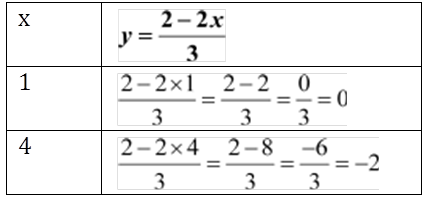
Similarly, a table can be drawn for the corresponding values of x and y for the equation 4x + 3y = 4 as
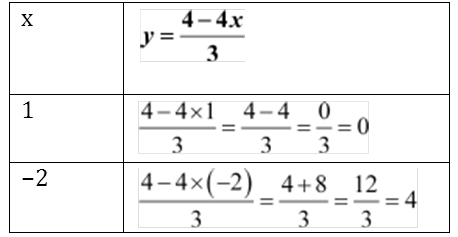
These points can now be plotted and joined to obtain the graphs of the equations as
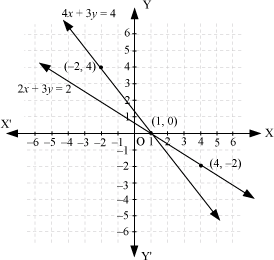
As seen in the graph, the two lines intersect at the point (1, 0). Thus, the given pair of linear equations is consistent with its solution as x = 1 and y = 0.
(b)x + y = 5
2x + 2y = 10
A table can be drawn for the corresponding values of x and y for the equation x + y = 5 as
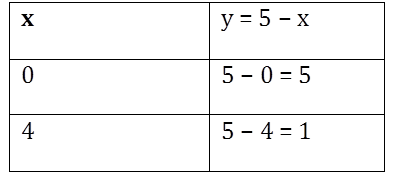
Similarly, a table can be drawn for the corresponding values of x and y for the equation 2x + 2y = 10 as
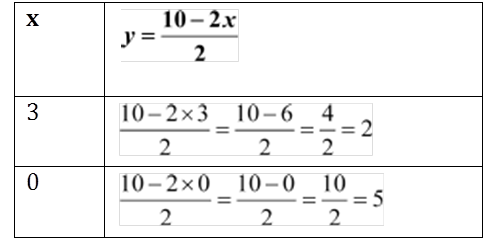
These points can now be plotted and joined to obtain the graphs of the lines as
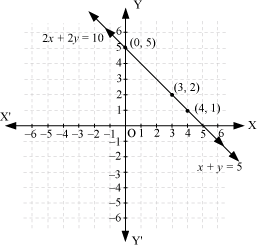
As seen in the graph, the two equations are represented by the same line. This means that the given pair of linear equations is dependent. Any point lying on this line is a solution to the pair of equations.
Substitution Method Of Solving Pairs Of Linear Equations
In a class, the number of boys is 7 more than twice the number of girls.
Can you find the number of boys and girls in the class? Let the number of boys be x and the number of girls be y. Now, according to the given condition,
x – 2y = 7
We cannot find the unique values of x and y by solving this equation because there are multiple values of x and y for which this equation holds true.
We can write the above equation as x = 2y + 7. Thus, by taking different values of y, we will obtain different values of x.
However, if we are given one more condition, then the values of x and y can be evaluated.
To solve a linear equation in two variables, two linear equations in the same two variables are required.
Let us consider one more condition. Suppose the total number of students in the class is 52.
Now, can you find the number of boys and girls in the class?
According to this condition, we can write x + y = 52
Therefore, we obtain a pair of linear equations in two variables.
x – 2y = 7
x + y = 52
Therefore, number of boys = 37 and number of girls = 15
In this method, we have substituted the value of one variable by expressing it in terms of the other variable to solve the pair of linear equations. That is why this method is known as the substitution method.
Now, let us solve some examples to understand this concept better.
Example 1: The sum of the digits of a two-digit number is 8. If 18 is added to the number, then the digits interchange their places. Find the number.
Example 2: Solve the following pair of linear equations.
7x – 5y + 12 = 0
3x + 8y – 5 = 0
Solution:
Given, 7x – 5y + 12 = 0 … (i)
3x + 8y – 5 = 0 … (ii)
From equation (i), we obtain
7x – 5y + 12 = 0

On substituting the value of y in equation (ii), we obtain
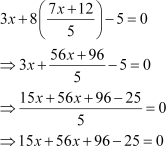
⇒ 71x + 71 = 0
⇒ 71x = – 71
⇒ x = – 1
Putting the value of x in equation (iii), we obtain
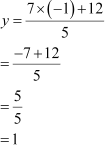
Therefore, x = – 1 and y = 1
Example 3: Arnab has few coins of Rs 5 and Rs 2 which together amount to Rs 167. If he has a total of 46 coins then find the number of both types of coins with him.
Solution:
Let the number of coins of Rs 2 be x and that of Rs 5 be y.
According to the question, we have
2x + 5y = 167 ...(i)
x + y = 46 ...(ii)
From equation (ii), we obtain
x = 46 – y ...(iii)
On substituting the value of x from equation (iii) in equation (i), we obtain
2(46 – y) + 5y = 167
⇒ 92 – 2y + 5y = 167
⇒ 92 + 3y = 167
⇒ 3y = 75
⇒ y = 25
On substituting the value of y in equation (ii), we obtain
x + 25 = 46
⇒ x = 21
Hence, Arnab has 21 coins of Rs 2 and 25 coins of Rs 5.
Example 4: A boat can travel 28 km downstream and 20 km upstream in 7 hours. Also, this boat can travel 21 km downstream and 18 km upstream in 6 hours. What is the speed of the boat in still water and the speed of the stream?
Solution:
Let x km/hr and y km/hr be the speed of the boat in still water and speed of the stream respectively.
Therefore,
Speed of the boat downstream = (x + y) km/hr
Speed of the boat upstream = (x – y) km/hr
∴ Time taken by the boat to travel 28 km downstream =  And, time taken by the boat to travel 20 km upstream =
And, time taken by the boat to travel 20 km upstream =  According to the question, we have
According to the question, we have

Now,
Time taken by the boat to travel 21 km downstream =  And, time taken by the boat to travel 18 km upstream =
And, time taken by the boat to travel 18 km upstream =  According to the question, we have
According to the question, we have

On substituting  in equation (i) and (ii), we obtain
in equation (i) and (ii), we obtain
28a + 20b = 7 ...(iii)
21a + 18b = 6 ...(iv)
From equation (iv), we obtain
7a + 6b = 2
⇒ 7a = 2 – 6b

On substituting the value of a from (v) in (iii), we obtain
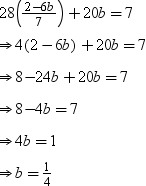
On putting this value of b in equation (v), we obtain

On resubstituting the values of a and b, we obtain

From (vii), we obtain x = y + 4. On substituting this value of x in (vi), we obtain
y + 4 + y = 14
⇒ 2y = 10
⇒ y = 5
On substituting y = 5 in (vii), we get
x – 5 = 4
⇒ x = 9
Thus, the speed of the boat in still water is 9 km/hr and the speed of stream is 5 km/hr.
Elimination Method To Solve A Pair Of Linear Equations
There are many real life situations which can be represented in the form of linear equations. Let us begin with such a situation.
Suppose you go to the market with your friend to buy clothes. You buy 3 shirts and 6 pairs of jeans from a shop and the total cost of your purchase comes out to be Rs 7000. Your friend, on the other hand buys 2 shirts and 3 pairs of jeans and the total cost of his purchase comes out to be Rs 3855. Now, we can represent this information mathematically as pair of linear equations in two variables. We can then solve the equations and get the
cost of each shirt and each pair of jeans. Let’s look at the following video to learn how to mathematically represent the information and then solve them using the elimination method.
Example 2: Solve the following equations using elimination method.
3x + 4y = 0
4x – 3y = 50
Solution:
Given,
3x + 4y = 0 … (i)
4x – 3y = 50 … (ii)
On multiplying equation (i) by 3 and equation (ii) by 4, we obtain
9x + 12y = 0 … (iii)
16x – 12y = 200 … (iv)
On adding equation (iii) and (iv), we obtain
25x = 200

Putting the value of x in equation (i), we obtain
3 × 8 + 4y = 0
⇒ 4y = − 24

Thus, x = 8 and y = − 6.
Example 3: Solve the following equations using elimination method.
7x + 5y = 43
5x + 7y = 41
Solution:
Given,
7x + 5y = 43 … (i)
5x + 7y = 41 … (ii)
It can be observed that coefficients of x and y in equation (i) are interchanged in equation (ii).
Let us add both the equations as follows:

⇒ 12(x + y) = 84
⇒ x + y = 7 ...(iii)
Now, let us subtract equation (ii) from equation (i) as follows:

⇒ 2(x – y) = 2
⇒ x – y = 1 ...(iv)
On adding equations (iii) and (iv), we obtain

⇒ x = 4
On putting the value of x in equation (i), we obtain
7 × 4 + 5y = 43
⇒ 28 + 5y = 43
⇒ 5y = 15
⇒ y = 3
Thus, x = 4 and y = 3.
Example 5: Five units of a solution are obtained by mixing two liquids A and B. If the liquids A and B are used in the ratio as 2 : 3 then the total cost comes out to be Rs 50.
Also, if the liquids A and B are used in the ratio as 3 : 2 then the total cost increases by 10%. Find the cost of per unit of each of the liquids A and B.
Solution:
Let x and y be costs of per unit of liquids A and B respectively. According to the question, we have
2x + 3y = 50 ...(i)
And
3x + 2y = 50 + 10% of 50
3x + 2y = 50 + 5
3x + 2y = 55 ...(ii)
On multiplying equation (i) by 3 and equation (ii) by 2, we obtain
6x + 9y = 150 ...(iii)
6x + 4y = 110 ...(iv)
On subtracting equation (iv) from equation (iii), we obtain
5y = 40
⇒ y = 8
On substituting y = 8 in equation (ii), we obtain
3x + 2(8) = 55
⇒ 3x + 16 = 55
⇒ 3x = 39
⇒ x = 13
Hence, the cost of per unit of liquid A is Rs 13 an that of liquid B is Rs 8.
Example 6: Some friends ate 5 pizzas and 3 burgers for which they paid Rs 445. One of them said "If the numbers of pizzas and burgers would have been exchanged, we would pay Rs 50 less." What is the cost of a pizza and that of a burger?
Solution:
Let the cost of a pizza be Rs x and that of a burger be Rs y.
∴ Cost of 5 pizzas = Rs 5x And, cost of 3 burgers = Rs 3y
According to the first condition, we have
5x + 3y = 445 ...(i)
Similarly, for the second condition, we have
3x + 5y = 445 – 50
⇒ 3x + 5y = 395 ...(ii)
On multiplying equation (i) by 3 and equation (ii) by 5, we obtain
15x + 9y = 1335 ...(iii)
15x + 25y = 1975 ...(iv)
On subtracting equation (iii) from equation (iv), we obtain
16y = 640
⇒ y = 40
On substituting y = 40 in equation (ii), we obtain
3x + 5(40) = 395
⇒ 3x + 200 = 395
⇒ 3x = 195
⇒ x = 65
Thus, cost of a pizza is Rs 65 and that of a burger is Rs 40.
Cross-Multiplication Method Of Solving Pairs Of Linear Equations
We can represent many situations in real life as linear equation in two variables. Let us consider such a situation.
Suppose Samay is older than Sumit by 30 years. After 5 years, Samay will be thrice as old as Sumit.
Can we find the present ages of Samay and Sumit?
Yes, we can find the present ages. However, before that, we have to represent this situation in the form of linear equations in two variables. Let us see how we can represent the above given situations as linear equations.
Let the present age of Samay be x years and the present age of Sumit be y years.
It is given that Samay is older than Sumit by 30 years. Thus, according to this condition, we have
x – y = 30
After 5 years, the age of Samay will be(x + 5) years and the age of Sumit will be (y + 5) years. However, it is given that after 5 years, Samay will be thrice as old as Sumit. Thus, we have
x + 5 = 3 (y + 5)
⇒ x + 5 = 3y + 15
⇒ x – 3y = 10
Now, we obtain the pair of linear equations as follows:
x – y = 30 … (1)
x – 3y = 10 … (2)
We can find the present ages of Samay and Sumit by solving the above equations for variables x and y.
We know three methods to solve a pair of linear equations.
(i) Substitution method
(ii) Elimination method
(iii) Graphical method
Now, we will follow another method to solve linear equations in two variables. This method is known as Cross-multiplication method. Firstly, let us discuss this method and after that we will solve the above equations for x and y. So, go through the following video to understand the cross-multiplication method and how it is applied to solve the above given equations.
Therefore, the present ages of Samay and Sumit are 40 years and 10 years respectively.
In this way, we can solve a pair of linear equations in two variables by cross-multiplication method.
We could solve these linear equations in two variables by other methods also. But why should we use cross-multiplication method to solve linear equations?
The cross-multiplication method is easier as compared to the other methods if the coefficients of variables in the equations are large numbers or numbers that look complex. To understand this concept better, let us see the following examples.
Example 2: Solve the following pair of linear equations in two variables by cross- multiplication method.
ax + by = a2 + b2 and
x + y = 2a Solution:
The above two equations can be written as
ax + by – (a2 + b2) = 0 … (1)
x + y – 2a = 0 … (2)
From the above two equations, we obtain
a1 = a, b1 = b, c1 = – (a2 + b2) and
a2 = 1, b2 = 1, c2 = – 2a
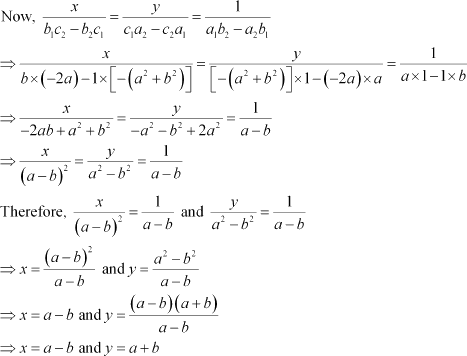
Equations Reducible To A Pair Of Linear Equations In Two Variables
Consider the following equations.
x = y; x = 21y + 15; m + 20n = –13; etc.
x = 21y + 15; m + 20n = –13; etc.
We can see that the above equations are linear equations in two variables. However, there are many equations, which do not appear to be linear equations at first glance such as

Now, can we solve these equations?
Example1: Solve the following pair of linear equations.

Solution:

From equation (1), we can write,

From equation (2), we can write,

Now, equation (3) becomes 5a + b = 7 … (5)
and equation (4) becomes 2a – 3b = – 4 … (6)
On multiplying (5) by 3, we obtain
15a + 3b = 21 … (7)
On adding equations (6) and (7), we obtain
17a = 17
⇒ a = 1
On putting the value of a in equation (5), we obtain
5 × 1 + b = 7
⇒ 5 + b = 7
⇒ b = 7 – 5 = 2
Since  = a = 1
= a = 1
⇒ x = 1
and  = b = 2
= b = 2
⇒ y =
Thus, x = 1 and y =
Example2: Solve the following pair of linear equations.

Solution:
The given equations can be written as
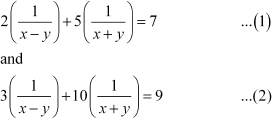

Thus, the equations become
2a + 5b = 7 … (3)
And, 3a + 10b = 9 … (4)
Now, on multiplying equation (3) by 2, we obtain
4a + 10b = 14 … (5)
On subtracting equation (4) from equation (5), we obtain
a = 14 – 9
 a = 5
a = 5
Putting the value of a in equation (3), we obtain
10 + 5b = 7
 5b = 7 – 10
5b = 7 – 10
 b =
b =

On adding these two equations, we obtain
2x =


Thus,

 ACERISE INDIA
ACERISE INDIA
